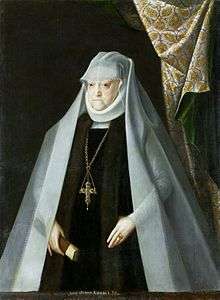Wimple

A wimple is a garment worn around the neck and chin, and which usually covers the head. Its use developed among women in early medieval Europe. At many stages of medieval culture it was unseemly for a married woman to show her hair. A wimple might be elaborately starched, and creased and folded in prescribed ways, even supported on wire or wicker framing (cornette).
Italian women abandoned their head cloths in the 15th century, or replaced them with transparent gauze, and showed their elaborate braids. Both elaborate laundry and elaborate braiding demonstrated status, in that such grooming was being performed by others. Today the wimple is worn by some nuns who still do the traditional habit.[1]
In literature
Geoffrey Chaucer in his Canterbury Tales has the Wife of Bath and also the Prioress depicted wearing them.
The King James Version of the Bible explicitly lists wimples in Isaiah 3:22 as one of a list of female fineries, however the Hebrew word "miṭpaḥoth" (וְהַמִּטְפָּחוֹת) means kerchief.
In Stephen King's Dark Tower related novella "The Little Sisters of Eluria", the sisters of Eluria are depicted as wearing wimples.
See also
- Christian headcovering
- Headpiece
- Headscarf
- Hijab, the Islamic head covering worn by Muslim women
- Veil
References
- ↑ Heron, Lynford (January 18, 2003). "Woman, Prayer & Head Covering". Centurion Ministry. Archived from the original on 2010-03-18.